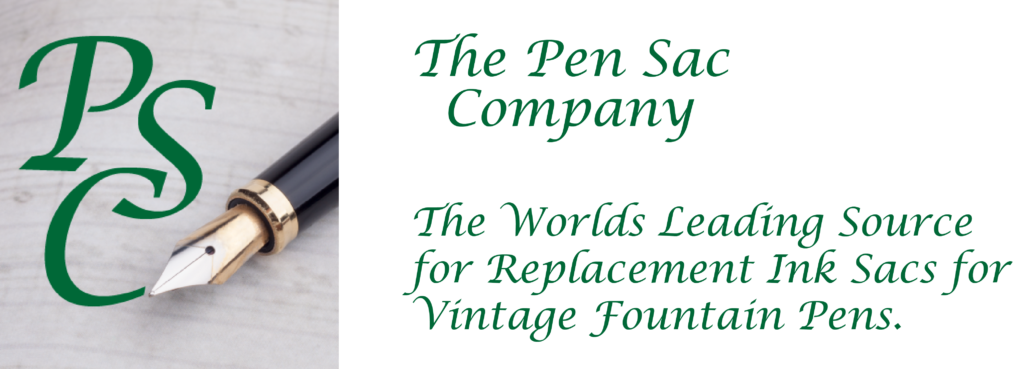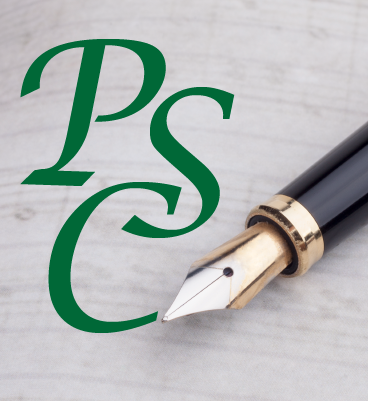
In 1925, a young engineer named Harry Hutchinson found employment with the White Rubber Company of Ravenna, Ohio. Although White Rubber had been producing ink sacs for the relatively new self filling fountain pens since 1919, one of the first projects entrusted to Mr. Hutchinson was to design an entire modern and efficient production line. Apparently Mr. Sterling Smith, the founder and president of White Rubber, had decided that the self-filling fountain was an invention with some promise.
By 1926, Harry’s machinery had been assembled and installed. It was obviously “state of the art” during the Golden Age of heavy industry in mid-western America. The chemical solutions and liquid latex were kept in constant circulation by powerful electric motors and gleaming stainless steel turbines. The forms which were dipped, 384 at a time, into latex to actually produce the sacs were machined from aluminum bars to an exact shape within one thousands of an inch in tolerance. The sacs were trimmed to precise length by eight high speed, powerful flying shear style trimmers (not currently used). The cast iron leaching tank where salts were soaked out of the sacs was forty feet long and ten feet wide, and the drying and curing oven could easily hold a dozen men standing upright. All this magnificent equipment was comfortably housed in a two-story brick building which had previously been used as an maintenance and repair facility for automobiles another new mechanical contraption of the early twentieth century. Ravenna had lost its Buick dealership but had gained White Rubber Company plant number 2. (The lovely color Buick logo can still be seen today on the side of the building)
Mr. Hutchinson’s ingenuity and Mr. Smith’s foresight soon began to pay off, and, for the next 60 years, the White Rubber Company was the leading manufacturer of ink sacs in the United States. White supplied sacs to Parker, Sheaffer, Waterman, Wahl, Conklin, Wearever and Esterbrook. Pen Companies from all over the world received shipments from Ravenna, Ohio. At the height of production Harry’s equipment was operated 24 hours a day, seven days a week turning out more than one hundred million sacs annually. Virtually all of the fountain pens which are today sought by collectors were fitted originally with sacs from the White Rubber Company.
With the advent of the ball point pen, the demand for ink sacs began to wane. During the 1960’s production figures remained respectable, but the decade following saw sales drop to a fraction of the previous peaks, and in the early 1980’s the production line was finally shut down. Although White Rubber Company, having diversified into making high quality insulated gloves, continued to thrive, the last source of fountain pen sacs in the country was no more.
In 1985, Harry Hutchinson’s machinery and the remaining inventory of 1.2 Million sacs was put up for sale. Although a number of expert pen collectors from around the country considered the purchase, there were a number of serious obstacles. The equipment was very dirty and in questionable repair. The manufacturing process was lengthy and somewhat complicated. The inventory, though large, was devoid of the larger and more useful sizes. As a result, there were no buyers, and it appeared, for a time, that the equipment would be scrapped and the techniques for making ink sacs would be lost forever. It was in December of 1986 that two fellows from California, Peter Amis and Bob Tefft, came along with enough enthusiasm and sufficient ignorance to purchase the facilities sight unseen.
Bob and Peter first laid eyes on their pen sac machinery in March of 1986 in Ravenna. At first, the situation didn’t look too bright. The weather was frigid and snowing, the motor which stirred the latex tank was broken, the drain on the leach tank was clogged. All of this, however, was easily overcome by the warmth and generosity of the people at White Rubber. Jim McCoy, who was one of the last men to work in the pen sac plant repaired and cleaned the equipment, assembled the forms that we needed, and taught us the manufacturing process. He often spent six or eight hours a day with us before heading over to his regular job to put in a complete shift making gloves. Frank Pemberton, with over 30 years in the ink sac department, came out of retirement to share his experience. Merle, one of the supervisors, showed us how to operate the boiler and vulcanizer. Thanks to their efforts, we became full-fledged pen sac dippers and managed to turn out about sixty thousand sacs in the most needed sizes. Even Harry Hutchinson, 84 years young, stopped to wish us well and to share some of his wonderful memories.
So, thanks to Jim, Merle, Frank, Harry, Barb and Dick, the Pen Sac Company got off to a good start. Now almost 10 years later, we are still using that great old equipment brought back from the edge of extinction to make sacs for all models of pens. We are still a small company and take great pride in continuing the tradition started by White Rubber Company so many years ago to manufacture ink sacs so that today you can enjoy the feel and use of these wonderful old pens.
This catalog of replacement ink sacs for various makes and models of vintage fountain pens has been prepared by the owners of the Pen Sac Company in response to many requests from our customers over the past few years. It is the result of many hours of research into company Catalogs and Service Manuals, as well as experience gained in repairing pens in our own collections. One of the unique features of this listing that, in many instances, the sac recommended is the exact size and shape of the original fitted at the factory and manufactured on the same equipment and by the same process as the original. This enables collectors not merely to repair a pen so that it will hold ink, but to actually restore the filling mechanism to brand new condition. We believe that, as enthusiasts become more sophisticated and as pens become more valuable, an ill fitted sac will be as disagreeable as a replacement clip or lever box. The Pen Sac Company is pleased to make this material available, and hopes that it will, in a small way, contribute to your enjoyment of our mutual hobby.
Ink sacs are generally identified by shape and by size. The two basic shapes are straight sacs which are of constant diameter over their entire length, and necked sacs which become more narrow near the opening or mouth of the sac.

When available in an appropriate size, the necked sac is usually preferable, as it affords a somewhat tighter seal with the section, in some cases, such as, the larger Parker button fillers it is essential for the proper working of the filling mechanism.
A third shape is the tapered sac which becomes narrower toward the bottom end, forming a cone shape. Fortunately, these are encountered in only a few limited applications, such as the Eversharp Skyline and the Parker Aerometric filler units.
The size of a pen sac is designated by two numbers: the outside diameter or O.D., expressed in 64ths of an inch, and the length, in inches. Thus, a 15 x 2 1/4 sac is 15/64ths of an inch outside diameter and 2 1/4 inches in length. Specific length is more critical in necked sacs as straight sacs can be trimmed to any desired length. The straight sacs should be fitted into the pen to determine the correct length. We manufacture the sacs the longest possible length so they may be used in the greatest number of applications.
